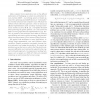Free Online Productivity Tools
i2Speak
i2Symbol
i2OCR
iTex2Img
iWeb2Print
iWeb2Shot
i2Type
iPdf2Split
iPdf2Merge
i2Bopomofo
i2Arabic
i2Style
i2Image
i2PDF
iLatex2Rtf
Sci2ools
CVPR
2007
IEEE
2007
IEEE
Optimizing Binary MRFs via Extended Roof Duality
Many computer vision applications rely on the efficient optimization of challenging, so-called non-submodular, binary pairwise MRFs. A promising graph cut based approach for optimizing such MRFs known as "roof duality" was recently introduced into computer vision. We study two methods which extend this approach. First, we discuss an efficient implementation of the "probing" technique introduced recently by Boros et al. [5]. It simplifies the MRF while preserving the global optimum. Our code is 400-700 faster on some graphs than the implementation of [5]. Second, we present a new technique which takes an arbitrary input labeling and tries to improve its energy. We give theoretical characterizations of local minima of this procedure. We applied both techniques to many applications, including image segmentation, new view synthesis, superresolution, diagram recognition, parameter learning, texture restoration, and image deconvolution. For several applications we see th...
Arbitrary Input Labeling | Binary Pairwise Mrfs | Computer Vision | CVPR 2007 | Efficient Implementation | Promising Graph Cut | Roof Duality Approach |
| Added | 12 Oct 2009 |
| Updated | 12 Oct 2009 |
| Type | Conference |
| Year | 2007 |
| Where | CVPR |
| Authors | Carsten Rother, Vladimir Kolmogorov, Victor S. Lempitsky, Martin Szummer |
Comments (0)

